Cannabis: IP Issues in a Budding U.S. Industry
Note: This post was written by Julia Justusson and was originally published on the ktMINE blog. Republished here with the author's permission.
Recommended reading: From ‘sativa’ to ‘CBD,’ common cannabis terms you need to know, via CTV News, Canada
Canada is already facing many challenges after its recent legalization of cannabis last week, including a significant shortage of product and uncertainties about border policies with the United States. Uruguay, which in 2013 became the first country to legalize recreational marijuana, has also faced difficulties in stabilizing and regulating this new market. Both countries face challenges in dealing with a substance they classify as legal, but which United States federal law finds illegal―Uruguay with its banking system and Canada with cannabis workers being potentially deemed inadmissible to cross the border into America if they admit to working in the industry.
While marijuana is federally illegal in the United States, some states have legalized it for medical purposes and others for both medical and recreational use. This direct contradiction of federal and state laws has led to a messy state of affairs for the cannabis industry, where legal ambiguity and confusion about formal laws and policies are the norm even as the marijuana market’s growth shows no sign of stopping. Earlier this year, New Frontier Data forecast that the legal U.S. cannabis market―worth an estimated $8.3 billion in 2017―would grow to almost $25 billion by 2025.
Intellectual property protections in the cannabis industry have complex requirements and are often unclear as a result of these differences between state and federal law. What even is the official position of the U.S. government on marijuana products, and how does this relate to intellectual property rights? In this article, we take a general look at marijuana in America and explore various consequences of its current questionable (il)legal status, particularly in regard to trademarks.
To Be Blunt, It’s Complicated
Under U.S. law at the federal level, marijuana is a Schedule I drug, categorized as having “no currently accepted medical use and a high potential for abuse.” (See this Vox article for an introductory explanation of the U.S. drug scheduling system.) The U.S. Food and Drug Administration has, however, approved several THC- and CBD-based medications, with more undergoing clinical trials. The FDA does not oppose the clinical investigation of cannabis for medical purposes, stating that “scientifically valid research … is the best way to determine what patients could benefit from the use of drugs derived from marijuana.”
The U.S. National Institutes of Health (NIH) has funded and carried out marijuana-related research over the years, investigating its potential for abuse and its potential as a medical treatment. The U.S. Department of Health and Human Services (HHS), as a result of this research, holds a patent on “Cannabinoids as Antioxidants and Neuroprotectants,” granted in 2003. (The NIH is a part of the Department of Health and Human Services.) This patent covers the use of cannabinoids for medical treatment, particularly neuroprotective functions (protecting the brain), without psychoactive effects.
An article in The Cannabist, an online newsletter publishing pieces on the state of the cannabis industry, included input from two IP lawyers regarding U.S. Patent No. 6,630,507. Sam Mendez, an intellectual property and public policy lawyer and executive director of the University of Washington’s Cannabis Law & Policy Project, has stated:
Naturally, it shows that there is a certain amount of hypocrisy that there is "no accepted medical use" for cannabis according to federal law. And yet … the very same government [owns] a patent for, ostensibly a medical use for marijuana.
The Department of Health and Human Services is licensing compounds under U.S. Patent 6,630,507 to Kannalife Sciences, a company developing cannabis-derived drugs for the treatment of various brain conditions. The Drug Enforcement Administration’s classification of cannabis and all its derivatives as a Schedule I substance with no accepted medical use is in blatant contradiction to the ownership and licensing of a patent based on that very substance for medical use by HHS, an arm of the federal government.
Gregory Wesner, a patent and trademark lawyer, says that the government is “basically…being two-faced.” Embodying that contradiction, Wesner has explained, is “the U.S. Patent and Trademark Office…. Patents have been granted for the utility of cannabinoids and other compounds. However, the issuance of trademarks will be murky until the legalization of marijuana is resolved on a federal level.”
Red Light, Green Light: Federal Prohibition, (Some) State Legalization
In the United States, medical marijuana is legal in 31 states. Of those, nine states have also legalized marijuana for recreational use by adults over 21. Washington, D.C., also allows both medical and recreational marijuana. The laws, fees, and possession limits vary from state to state.
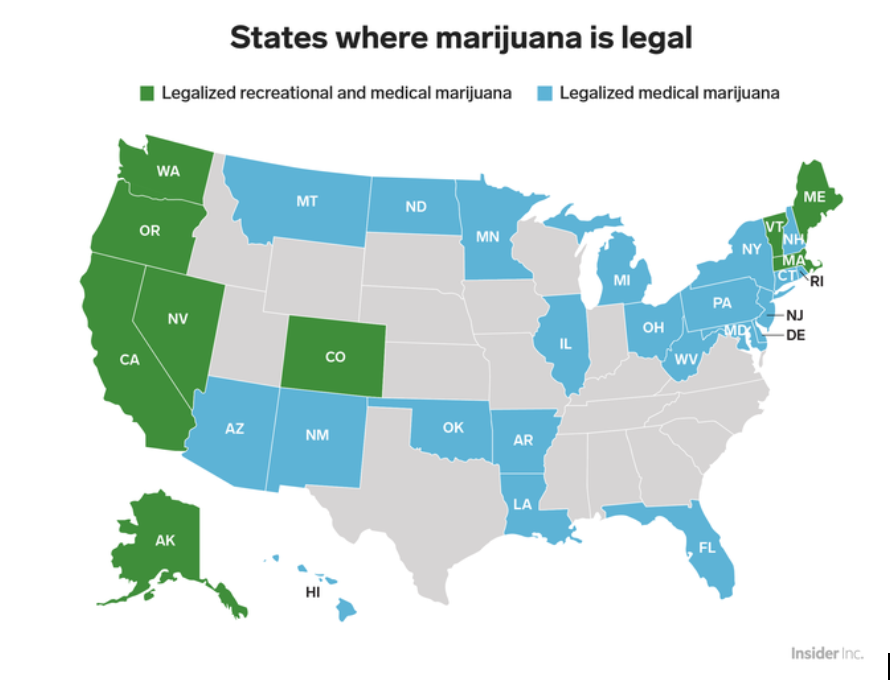
Source: Skye Gould, Business Insider
Again, as stated earlier, as a Schedule I drug under the Controlled Substances Act, cannabis in any form (“all parts of the plant Cannabis sativa L., whether growing or not; the seeds thereof; the resin extracted from any part of such plant; and every compound, manufacture, salt, derivative, mixture, or preparation of such plant, its seeds or resin,” see CSA text here) is illegal at the federal level.
In August 2013, under the Obama administration, former Deputy Attorney General James Cole issued a memorandum to all federal prosecutors. He wrote:
In jurisdictions that have enacted laws legalizing marijuana in some form and that have also implemented strong and effective regulatory and enforcement systems to control the cultivation, distribution, sale, and possession of marijuana … consistent with the traditional allocation of federal-state efforts in this area, enforcement of state law by state and local law enforcement and regulatory bodies should remain the primary means of addressing marijuana-related activity.
Cole’s memo suggested that prosecution of “marijuana-related activity” should not be a federal priority in states that had legalized it. Enforcement and action were essentially left up to state and local officials.
Early this year, under the current Trump administration, Attorney General Jeff Sessions issued a memo that rescinded the Cole memo. The Department of Justice’s Office of Public Affairs stated in a press release that “[this] return to the rule of law is also a return of trust and local control to federal prosecutors who know where and how to deploy Justice Department resources most effectively to reduce violent crime, stem the tide of the drug crisis, and dismantle criminal gangs.”
In a collection of opinions regarding Sessions’ memo published by Forbes, most industry experts agreed that rescinding the 2013 Cole memo would “heighten uncertainty in an industry seeking stability.” Frank Lane, president of a leading creative agency in the cannabis space, stated:
The Sessions memo shouldn’t have come as too much of a surprise given the Attorney General’s historical stance on marijuana, but it certainly adds a bit of uncertainty to the market. The upshot is that it could force members of both political parties to come together and finally draft some federal level regulations rather than relying on a patchwork of state regulations. This could be a net benefit to the industry over the long-term.
IP Consequences of Disjointed Regulations
This “patchwork” of varying state regulations existing alongside broad criminalization of marijuana at the federal level has led to a confusing state of affairs for cannabis businesses. Conflicting legislative approaches toward monitoring and managing marijuana activity have manifested in a challenging set of requirements to consider when dealing with intellectual property in the industry.
In 2015, Sam Kamin and Viva R. Moffat published Trademark Laundering, Useless Patents, and Other IP Challenges for the Marijuana Industry through the University of Denver College of Law, where they write:
[Federal] intellectual property (IP) protection is generally not available to marijuana businesses. Because the bulk of IP law is federal, the federal marijuana prohibition means that much of IP law is unavailable or effectively inaccessible to the marijuana industry. Worse yet, marijuana businesses are denied the regulatory benefits of IP law while remaining subject to its burdens.
Kamin and Moffat state that one consequence of this lack of IP protection at the federal level is that players in the marijuana industry are forced to assert their IP rights at the state level. They continue:
But state IP doctrines and related regulations were not created for the purposes they are being asked to serve and are often poor substitutes for federal protection. Perhaps because state law is such a poor substitute for federal IP protection, marijuana businesses have found ways, albeit roundabout, to access federal law, in particular, federal trademark protection. They do this by registering marks for consulting services, t-shirts, or other merchandise―all of which are perfectly legal under federal law―and then using these marks in connection with the sale of marijuana as well. We call this "trademark laundering."
So, while it is technically illegal to file a trademark protecting the name of any product derived from or mainly containing marijuana, the law hasn’t effectively stopped people and companies from doing just that.
This idea of “trademark laundering” posited above is supported by a look into cannabis- and marijuana-related trademarks in ktMINE’s database. Several companies are filing trademarks where the mark also happens to be the name of a particular strain of marijuana. The following is a sampling of registered trademarks―meaning they have been approved by the USPTO and are active―for phrases covering various types of goods and services that can also be found on this list of marijuana varieties:
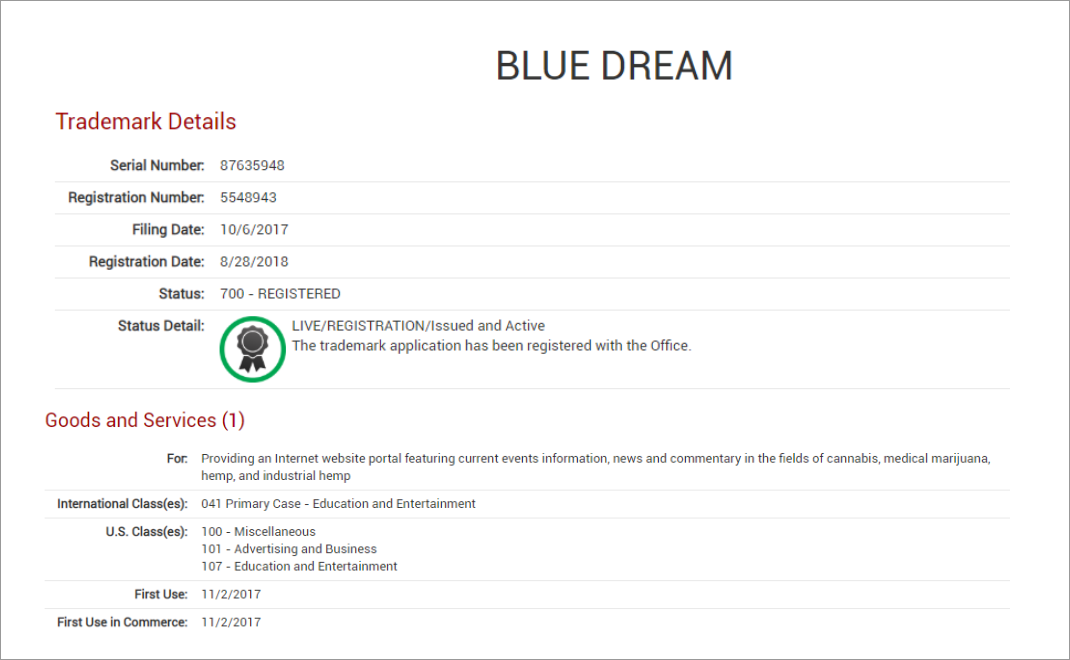
Source: ktMINE IP Platform contains millions of data points, from trademarks to licensed patents
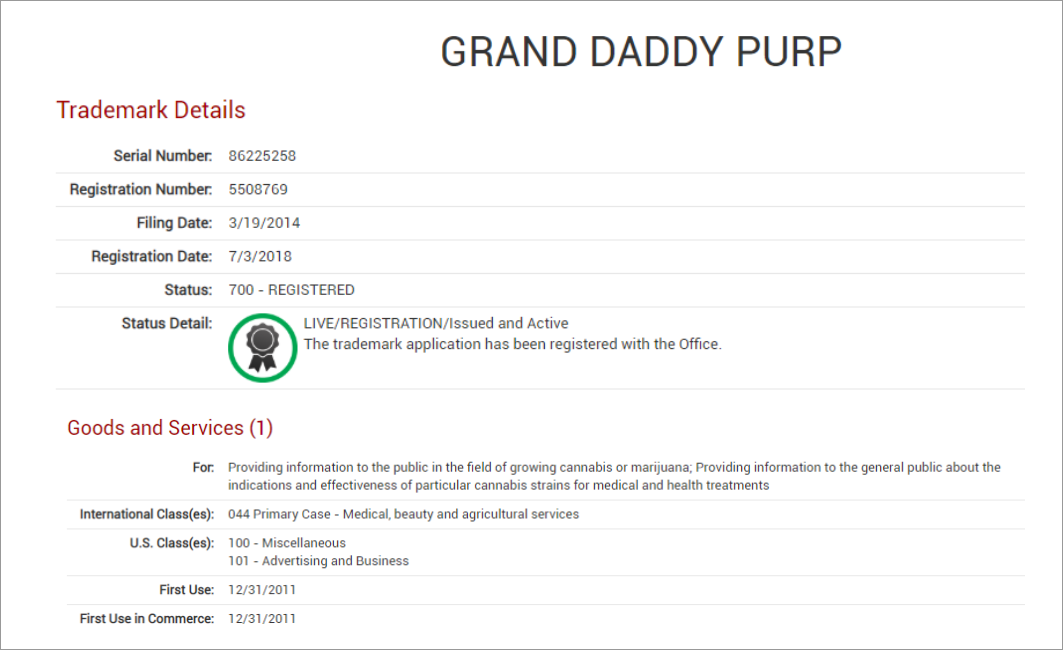
Source: ktMINE IP Platform contains millions of trademarks and assignments

Source: ktMINE IP Platform contains over 9.1 million trademark records
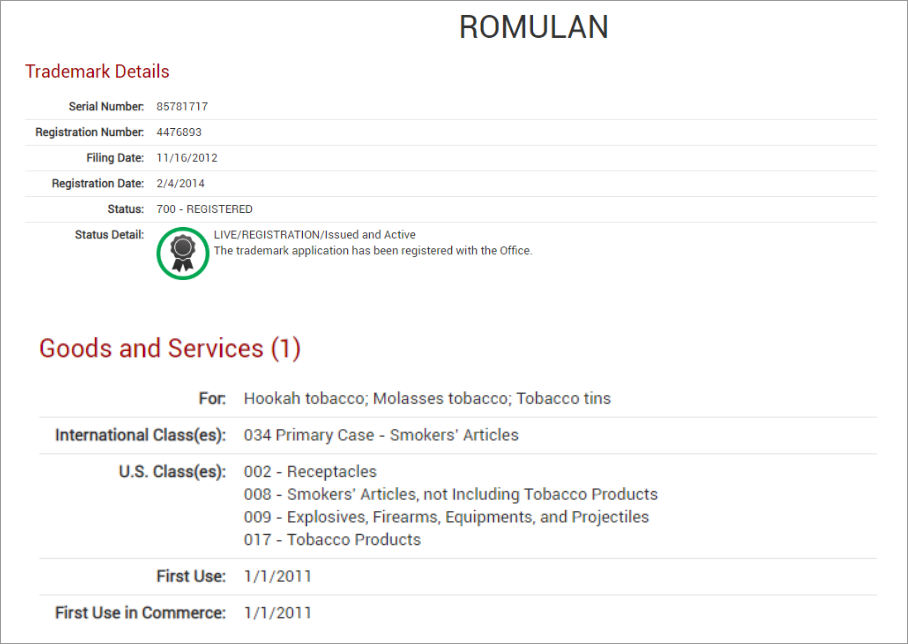
Source: ktMINE IP Platform contains over 9.1 million trademark records
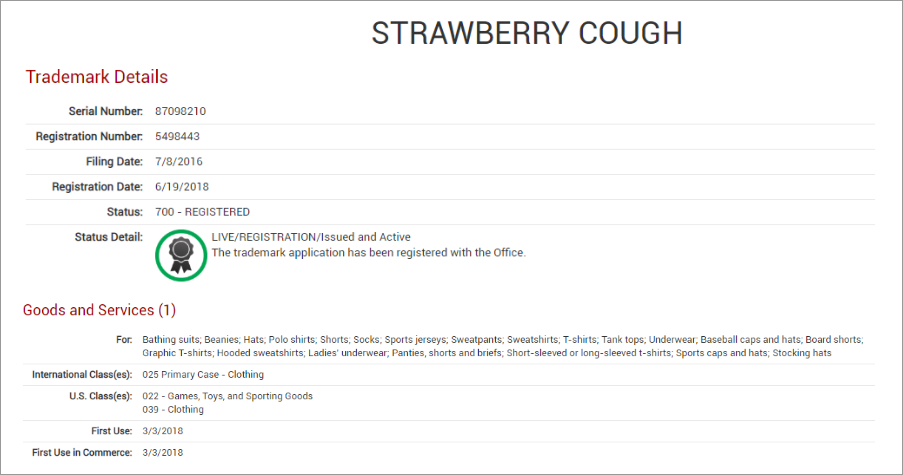
Source: ktMINE IP Platform contains millions of trademarks and assignments
There is no way to confirm with absolute certainty that the parties registering the above trademarks intend to (or already are) using these marks in connection with the sale of marijuana. However, it is a not uncommon practice for businesses in the industry to seek intellectual property protections for “everything … [they] can, tangential to the actual cannabis product itself.”
Marketing Marijuana: THC and Trademarks
Another search of the ktMINE trademarks database with keywords “cannabis” and “marijuana” suggests an interesting industry focus on protecting custom weed-related images and graphics and reveals an interesting innovator in the cannabis space.
Chicago Cannabis, for example, has filed a mark for a version of the Chicago flag with its stars replaced by marijuana leaves:
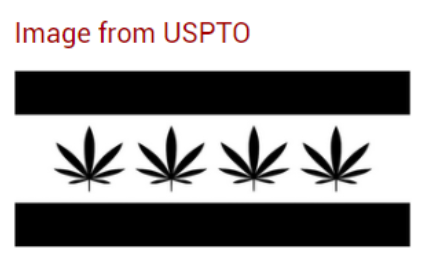
Source: ktMINE IP Platform
Loud Amerika LLC has a mark integrating a marijuana leaf into the American flag:
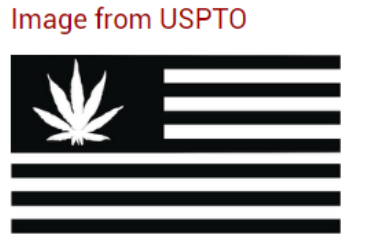
Source: ktMINE IP Platform contains millions of data points, from trademarks to licensed patents
Multiple parties have received registration rights on trademarked images with a focus on a single marijuana leaf:
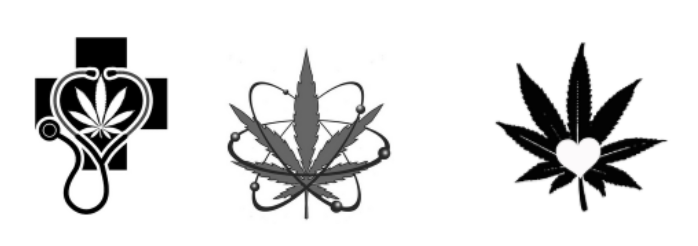
Source: ktMINE IP Platform
“Potbot” is an issued and active trademark covering software applications, data mining, and scientific research (including DNA analysis services) at the intersection of artificial intelligence and the cannabis field:
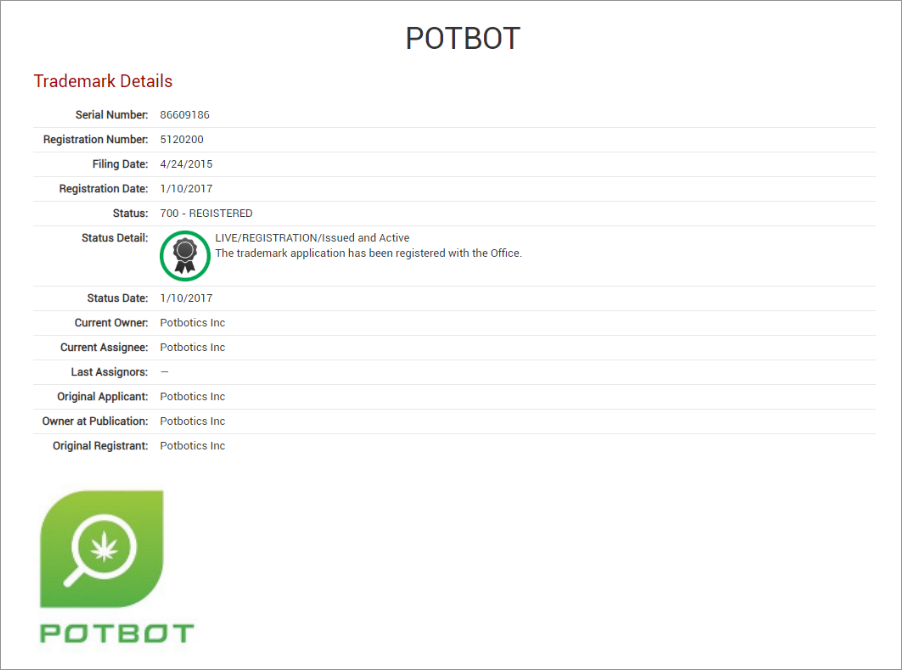
Source: IP Platform contains over 9.1 million trademark records
PotBotics, which owns this trademark, was founded in 2014. The company has a recommendation app that suggests strains and dosages to medical marijuana patients as well as recreational users under PotBot. PotBotics also provides a service to help healthcare professionals determine what cannabinoid levels are most helpful to their patients under the name Brainbot. In addition to “adding more scientific data and legitimacy to the medical marijuana industry,” the company hopes to help “provide more information and better access” to information about personalized cannabis therapy options to patients.
Infringement in the Industry: Bringing Down Buddafingers
Trademark infringement litigation is also coming into play in the marijuana industry. In June 2014, Hershey filed a lawsuit against TinctureBelle LLC for marketing edible marijuana products in packaging resembling Hershey candy wrappers. Hashees peanut butter cups, Hasheath bars, and Dabby Patty and Ganja Joy chocolate products were among the candies named in the lawsuit. (TinctureBelle also sold Twigz and Buddafingers, possibly modeled after Mars’ Twix and Nestle’s Butterfinger bars.) From the original complaint filed by Hershey:
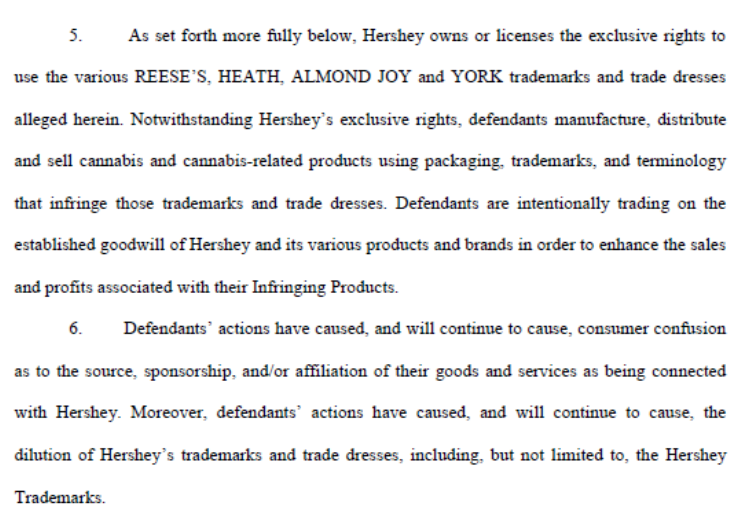
Hershey claimed Tincturebelle’s products infringed upon and diluted certain of Hershey’s well-known trademarks and filed suit under causes of trademark infringement, trademark dilution, false designation of origin, and unfair competition. Hershey included the following side-by-side comparison of several Hershey and TinctureBelle products in their complaint:
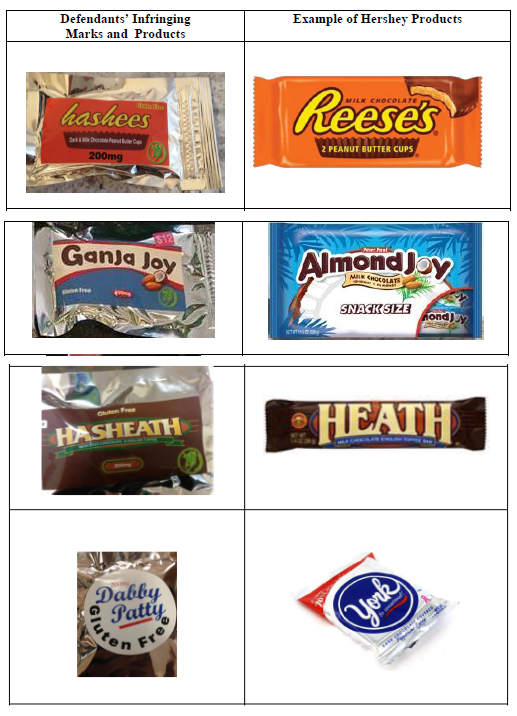
Source: The Hershey Company and Hershey Chocolate & Confectionery Corporation v. TinctureBelle LLC and TinctureBelle Marijuanka LLC, filed June 2014, United States District Court, District of Colorado
Hershey settled with TinctureBelle in September 2014, only a few months after filing its first complaint. TinctureBelle claimed to have stopped selling the infringing candies well before the lawsuit was filed, with its owner, Char Mayes, stating that:
The lawsuit from Hershey came as a huge surprise to us … We changed our entire label line approximately six months ago, long before these allegations surfaced. Our new packaging looks nothing like Hershey’s or anyone else’s.
TinctureBelle provided The Washington Post with photos of their new product packaging for some of the candies depicted above:

Source: The Washington Post
TinctureBelle and others have learned the hard way that parodying big brands more often than not leads to lawsuits and lost money. Marijuana companies must carefully consider how to best preserve the “tongue-in-cheek, alternative vibe” of cannabis culture while avoiding intellectual property violations.
A Dope Future? More Challenges Ahead
The cannabis industry is in a constant state of flux. Here, we have considered a fairly general overview of the U.S. marijuana IP landscape, with an additional focus on trademarking in particular.
Additional posts will explore the complex state of patent application and granting processes faced by players in the American marijuana industry, the potential movement of big agriculture from weed-killing into weed-growing, and considerations of cannabis IP strategies from an international perspective.
Keep an eye on the ktMINE blog for updates to this series.
About the author: Julia Justusson
As a ktMINE research analyst, Julia Justusson processes and examines intellectual property daily. Interested in tracking innovation across various fields through IP, she uses ktMINE to identify IP patterns that can provide insight into a company’s strategy and industry trends.
